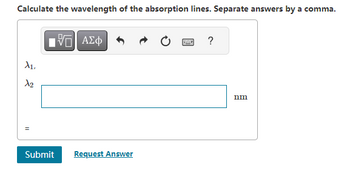The energy-level diagram for the atomic emission spectra of an unknown gas is presented in the diagram below. ▼ Part A Submit Request Answer n=4 ? n=3 n=2 n=1 4.2 eV 2.4 eV Initially, electrons are in both the ground and first excited state (n=1 and n=2). A beam of light hits the gas. This beam is a continuous spectrum of yellow/green light (from 495 nm to 590 nm) How many absorption line/s will there be in the spectra? [5] ΑΣΦ 2.0 eV 0 eV BEG YO Color Wavelength Frequency violet 380-450 nm 668-789 THz blue 450-495 nm 606-668 THz green 495-570 nm 526-606 THz yellow 570-590 nm 508-526 THz orange 590-620 nm 484-508 THz red 620-750 nm 400-484 THz Photon energy 2.75-3.26 eV 2.50-2.75 eV 2.17-2.50 eV 2.10-2.17 eV 2.00-2.10 eV 1.65-2.00 eV
The energy-level diagram for the atomic emission spectra of an unknown gas is presented in the diagram below. ▼ Part A Submit Request Answer n=4 ? n=3 n=2 n=1 4.2 eV 2.4 eV Initially, electrons are in both the ground and first excited state (n=1 and n=2). A beam of light hits the gas. This beam is a continuous spectrum of yellow/green light (from 495 nm to 590 nm) How many absorption line/s will there be in the spectra? [5] ΑΣΦ 2.0 eV 0 eV BEG YO Color Wavelength Frequency violet 380-450 nm 668-789 THz blue 450-495 nm 606-668 THz green 495-570 nm 526-606 THz yellow 570-590 nm 508-526 THz orange 590-620 nm 484-508 THz red 620-750 nm 400-484 THz Photon energy 2.75-3.26 eV 2.50-2.75 eV 2.17-2.50 eV 2.10-2.17 eV 2.00-2.10 eV 1.65-2.00 eV
Principles of Physics: A Calculus-Based Text
5th Edition
ISBN:9781133104261
Author:Raymond A. Serway, John W. Jewett
Publisher:Raymond A. Serway, John W. Jewett
Chapter28: Quantum Physics
Section: Chapter Questions
Problem 25P
Related questions
Question
The energy-level diagram for the atomic

Transcribed Image Text:The energy-level diagram for the atomic emission spectra of an unknown gas is presented in the diagram below.
Part A
Submit
Request Answer
n=4
?
n = 3
n=2
n=1
4.2 eV
2.4 eV
Initially, electrons are in both the ground and first excited state (n=1 and n=2). A beam of light hits the gas. This beam is a continuous spectrum of yellow/green light (from 495 nm to 590 nm)
How many absorption line/s will there be in the spectra?
IVE ΑΣΦ
2.0 eV
0 eV
VE BE
GE|Y8|05|
Color Wavelength Frequency
violet 380-450 nm 668-789 THz
blue 450-495 nm 606-668 THz
green 495-570 nm 526-606 THz
yellow 570-590 nm 508-526 THz
orange 590-620 nm 484-508 THz
red 620-750 nm 400-484 THz
Photon energy
2.75-3.26 eV
2.50-2.75 eV
2.17-2.50 eV
2.10-2.17 eV
2.00-2.10 eV
1.65-2.00 eV
Expert Solution
This question has been solved!
Explore an expertly crafted, step-by-step solution for a thorough understanding of key concepts.
This is a popular solution!
Trending now
This is a popular solution!
Step by step
Solved in 3 steps

Follow-up Questions
Read through expert solutions to related follow-up questions below.
Follow-up Question
Calculate the wavelength of the absorption lines. Separate answers by a comma.

Transcribed Image Text:Calculate the wavelength of the absorption lines. Separate answers by a comma.
A₁,
X₂
11
[ΨΕΙ ΑΣΦ
Submit Request Answer
?
nm
Solution
Knowledge Booster
Learn more about
Need a deep-dive on the concept behind this application? Look no further. Learn more about this topic, physics and related others by exploring similar questions and additional content below.Recommended textbooks for you

Principles of Physics: A Calculus-Based Text
Physics
ISBN:
9781133104261
Author:
Raymond A. Serway, John W. Jewett
Publisher:
Cengage Learning

Physics for Scientists and Engineers with Modern …
Physics
ISBN:
9781337553292
Author:
Raymond A. Serway, John W. Jewett
Publisher:
Cengage Learning

College Physics
Physics
ISBN:
9781285737027
Author:
Raymond A. Serway, Chris Vuille
Publisher:
Cengage Learning

Principles of Physics: A Calculus-Based Text
Physics
ISBN:
9781133104261
Author:
Raymond A. Serway, John W. Jewett
Publisher:
Cengage Learning

Physics for Scientists and Engineers with Modern …
Physics
ISBN:
9781337553292
Author:
Raymond A. Serway, John W. Jewett
Publisher:
Cengage Learning

College Physics
Physics
ISBN:
9781285737027
Author:
Raymond A. Serway, Chris Vuille
Publisher:
Cengage Learning